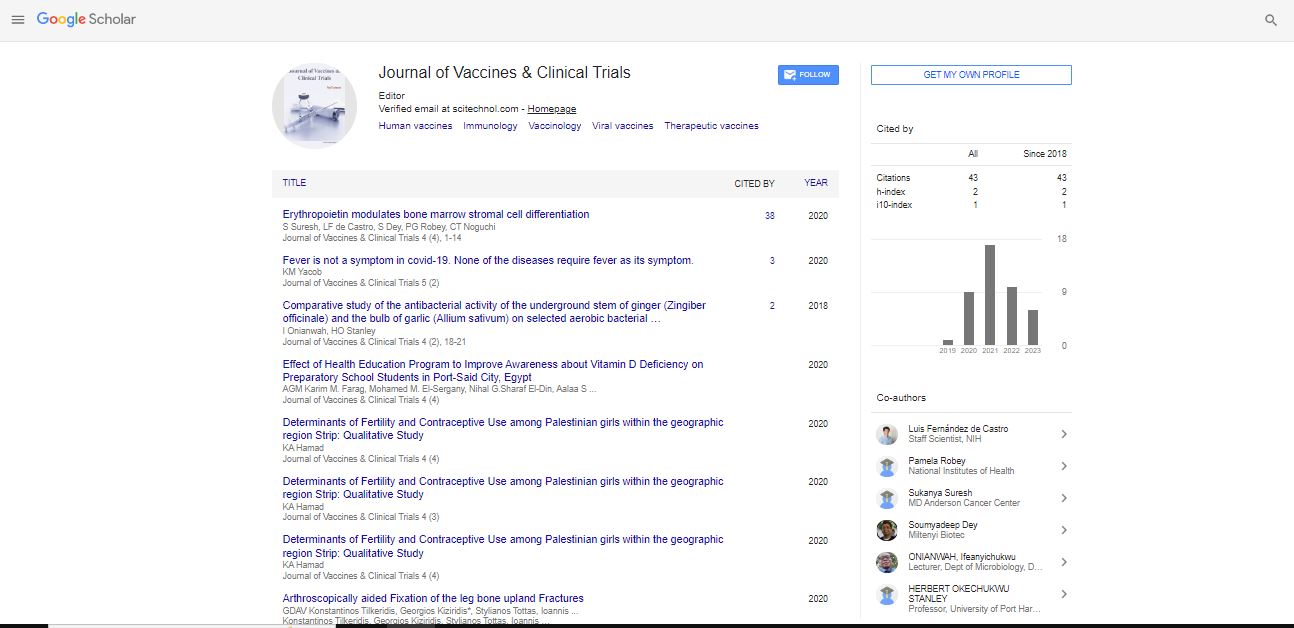Commentary, Jou Of Vac Cli Tr Vol: 7 Issue: 4
Global Impact on Influenza: Its Prevention and Treatment Methods
Huang Cheng*
1Department of Infectious Disease, China University of Geosciences, Wuhan, China
*Corresponding Author: Huang Cheng,
Department of Infectious Disease, China
University of Geosciences, Wuhan, China
E-mail: chenghuang@cug.edu.cn
Received date: 27 November, 2023, Manuscript No. JVCT-24-128359;
Editor assigned date: 30 November, 2023, PreQC No. JVCT-24-128359 (PQ);
Reviewed date: 07 December, 2023, QC No. JVCT-24-128359;
Revised date: 21 December, 2023, Manuscript No. JVCT-24-128359 (R);
Published date: 28 December, 2023 DOI: 10.4172/JVCT.100089
Citation: Cheng H (2023) Global Impact on Influenza: Its Prevention and Treatment Methods. Jou of Vac Cli Tr 7:4.
Description
Influenza, often simply called the flu, is a highly contagious viral infection that primarily affects the respiratory system. It's caused by influenza viruses that belong to the Orthomyxoviridae family. The flu is a widespread illness that can range from mild to severe and can lead to complications, especially in vulnerable populations.
Influenza has been documented throughout history, with some of the most devastating outbreaks occurring in the past centuries. There are three main types of influenza viruses: A, B, and C. Influenza A and B viruses are the most common types responsible for seasonal outbreaks in humans. Influenza A viruses are further classified into different subtypes based on their surface proteins, Hemagglutinin (H) and Neuraminidase (N). These subtypes, such as H1N1 and H3N2, often circulate among humans and can cause seasonal flu epidemics.
The flu spreads through respiratory droplets when an infected person coughs, sneezes, or talks. It can also spread by touching surfaces contaminated with the virus and then touching the face. Individuals infected with the flu are most contagious in the first few days after becoming sick, even before symptoms appear, making it challenging to control its spread.
Typical symptoms of the flu include fever, cough, sore throat, runny or stuffy nose, body aches, headache, fatigue, and sometimes vomiting and diarrhea, more commonly seen in children. Symptoms usually appear suddenly and can vary in severity, with some individuals experiencing mild illness while others face severe complications.
Most people recover from the flu without complications. However, certain groups are at higher risk of developing severe complications, including young children, elderly individuals, pregnant women, and those with underlying health conditions such as asthma, diabetes, or heart disease. Complications can include pneumonia, worsening of chronic medical conditions, and in severe cases, death.
Vaccination is the most effective way to prevent the flu. Annual flu vaccines are recommended, as the viruses can change over time, requiring updated vaccines to provide protection against the predominant strains. Antiviral medications, such as oseltamivir and zanamivir, can be prescribed to treat the flu and reduce the severity and duration of symptoms if taken early in the illness.
Public health measures play a crucial role in controlling the spread of the flu. Practices like frequent hand washing, covering coughs and sneezes, staying home when sick, and avoiding close contact with infected individuals help reduce transmission. During outbreaks or pandemics, authorities may implement additional measures like school closures or travel restrictions to limit the spread.
Influenza has a significant global impact, causing seasonal epidemics that affect millions of people worldwide each year. Additionally, influenza pandemics, which occur when a new influenza virus emerges and spreads globally, pose a serious threat to public health and can lead to substantial morbidity and mortality.
On-going research focuses on better understanding the influenza virus, developing more effective vaccines, and improving treatment options. Scientists continuously monitor flu viruses, studying their evolution and potential for causing outbreaks to enhance preparedness and response strategies against future flu pandemics.
Influenza remains a prevalent and potentially severe illness, capable of causing widespread outbreaks and impacting global health. While advancements in research, vaccination, and public health measures have helped mitigate its impact, continuous vigilance, education, and innovation are essential in combating the flu and reducing its burden on society.
 Spanish
Spanish  Chinese
Chinese  Russian
Russian  German
German  French
French  Japanese
Japanese  Portuguese
Portuguese  Hindi
Hindi 